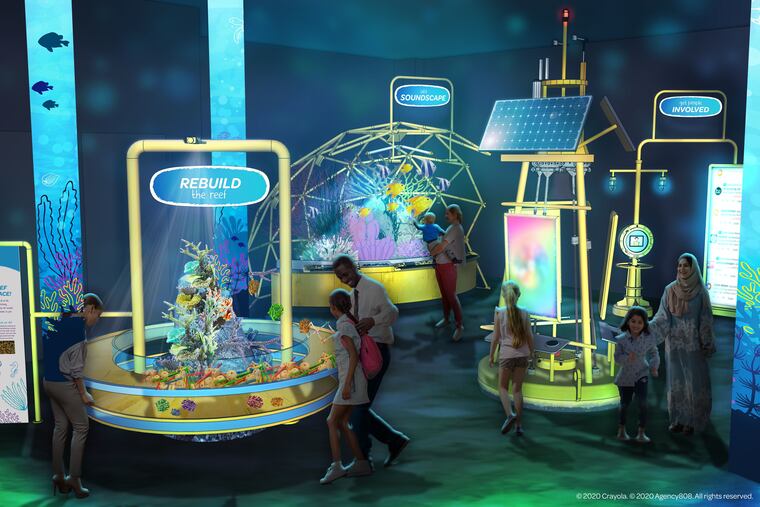Franklin Institute and Crayola are building an idea space of the future, opening Feb. 2021
Working with Crayola, the science museum is planning a show that breaks down the creative process and takes visitors from beneath the sea into outer space. Don't expect crayons, though.

There are no burnt sienna crayons in a big Crayola exhibition recently announced by the Franklin Institute for next February.
No violet.
No metallic seaweed.
Instead of crayons in the 120 colors the Easton, Pa.-based company currently produces, instead of rooms of Silly Putty (another Crayola childhood fave), “Crayola IDEAworks: The Creativity Exhibition” aims to explore the nature of problem solving in a brand-inspired interactive exhibition.
“This is very much about a concept and the concept is that you, the guests, are creative, and you make thousands of creative decisions every single day,” said Clayton Ferguson, a founder and executive producer of Agency808, which bills itself on its website as “a creative agency that serves children, their families and the brands they love.”
“We want to empower you to understand the steps to go through that process. So you’re really equipped to then walk into a very deep creative experience,” he said.
Agency808 does not build exhibits and installations; they construct “experiences.” This one is a joint effort involving the firm, the Franklin Institute, and Crayola.
“The first thing you’re going to get is an RFID wristband that’s going to be your companion through the entire exhibition,” said Ferguson. This wireless radio frequency ID will squirrel away your answers and choices as you move through foam blocks and touch screens and puzzles in the first half of the exhibition, building a kind of individualized creative profile.
This first section seeks to profile “how your brain works right now,” he said, by storing the answers to various interactive head scratchers: What is important to know when searching for your lost dog — what it looks like or whether it likes bones?
A visitor passes through four “hubs” or “stations” to identify the problem, define the details, explore the options, and assess the solution. Voila! IDEA!
“Under each of those letters there are two skills. So under ‘identify,’ for instance, you’re learning to listen and observe," said Abby Bysshe, the Franklin Institute’s vice president for business development.
"You’re trying to figure out what the problem is that you’re trying to solve. And you do that through listening and observing. The interactive with the dog is about learning what that problem is and figuring out how to answer that problem.”
In one of the stations, she said, a visitor is given an octopus, a broom, and a motorcycle, “and the question is, can you create a machine to clean up the beach.” Another station has a “build area” full of foam blocks and shapes and “you’re again challenged, to build a chair that can hold your own weight.”
The point of all this is to create, build, test, retest, and test again, all the while engaging in a version of the process of creation. There are no “right” answers.
“We’re trying to really collect and be able to help teach everybody, be it a young kid or adult, what their creative strengths are,” said Ferguson. “It’s a mix of digital and tactile so it’s not just a giant digital experience.”
Now entering the ‘Colorverse’
The individualized creative profiles, stored in the RFID wristbands, help guide visitors through the second part of the exhibition — Colorverse, which encompasses City of Crayopolis, Seabase, and Mars Colony.
“We dump you into a really fun, open area .... where you can use these concepts in action,” Ferguson said.
In Crayopolis, urban planning is the goal. In Seabase, it’s rebuilding a reef. In Mars Colony, it’s figuring out simply how to be. All these areas are vividly rendered in the Crayola palette.
In Seabase, the coral reef is dying, Ferguson said.
“It’s all about like fish really. If you go in there,” he continued, "the fish emit sounds like grunts, whoops, crunches, and clicks. When there’s no fish around, there’s no sound. And so the idea is that by creating sounds — everybody creating different whoops, grunts, all of those different sounds, on individual organ-style soundscapes — by putting those together, fish start coming back to the coral reef.”
The more sounds people string together, the more fish return to Seabase and “you start seeing the reef come back to life.”
In another section of Seabase, the coral reef is rebuilt. “It’s about using rock work and magnetics and cooperation to rebuild that reef together so you’re trying to put the reef back together using a coordinated-style approach,” said Ferguson.
In City of Crayopolis, the exhibition takes on the difficulties of land use. (No, it is not about the game of zoning.) And on Mars, you figure out how to design and throw a ball in a zero-gravity environment. You ponder how to grow food with minimal water and oxygen. And you can give an interview as a returning astronaut.
All of this — ocean, outer space, urban cityscape — is contained within about 10,000 square feet, part of a much larger exhibition space, which allows for ample social distancing.
In addition to distancing, Bysshe said that all of the Franklin Institute’s coronavirus safety protocols will be in place, with extensive sanitizing washdowns of interactives and other social spaces.
The exhibition is slated to open Feb. 13 for a run through July 18. Tickets are available online at the Franklin Institute website, fi.edu.